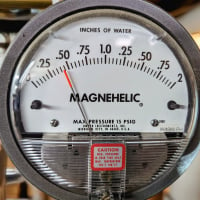Best Of
Re: Looking for help with my AC condenser
pecmsg, when using a Cap in parallel you add all the MFD together to get the total so 40 + 3 wired parallel = 43 MFD.
That is why the Turbo 200 is such a good part to have on your truck. It fits almost anything you need and it has a 3 year warranty.
When wired in series the equation looks like this:
That is how I came up with the 2.79 for the 40+3 dual CAP wired in series. When wired like smore1945 indicated in his original post, then the diagram for the CAP looks like this
because the COM terminal connects both the 3 and the 40 in series. This is not the intended use for that CAP, but when you make the mistake and wire it this way, you get what you get.
smore1945 got lucky and was able to save the system by getting it cack the way it is supposed to be.
Re: Boiler
"supposed" to be no unbreakable specs on public bid jobs like schools. They "have" to accept an = but you know how that goes.
But the boiler mfg sales reps get the engineer to spec their boiler and they do that but will accept an =. So then the boiler mfg works on the contractors to bid their boiler because it is spec and the contractor who get the bid will buy the cheapest boiler he can find that will get approved usually buying the one the engineer spec all thing being = especially the price. Burnham must have had good pricing because they took over the market around here for a long time. Probably why Smith who is 10 miles from me and had the market sewn up for 100 years is basically out of business,
Re: finding a leak in a mini-split
as am I but sometimes you’ve got to do what you’ve got to do.
 pecmsg
pecmsg
Re: Is this a house trap?
This has gone on much too long….
When I first read this
Is this a House Trap
I was going to answer with:
I don't know; but this is a mouse trap! LOL
But now that this is 3 pages long, I had to add this comment to the discussion.
Re: Off grid heating/ac minisplit efficiency
Minisplits want clean AC power with good Hertz control.
As do modern boilers that have a fair amount of electronics inside.
Re: Off grid heating/ac minisplit efficiency
Where is this cabin located? What's the typical humidity there?
 ChrisJ
ChrisJ
Re: Help Sizing a Mini Split System
The current version of Mitsubishi's design software, Diamond System Builder, does mini & multi splits and is freely available at mylinkdrive.com (or trane.mylinkdrive.com if you prefer). It won't help with the sizing, but it will guarantee that everything's compatible, including over/under committing indoor sizing vs outdoor sizing.
Mitsubishi/Tranes are more expensive, but they make up for it with better install training, tech support, & parts availability.
I'm not a dealer, but I have taken the VRF install courses. Very hands-on.
Re: Off grid heating/ac minisplit efficiency
the computers that control everything require a clean sign wave.
 pecmsg
pecmsg
Re: Steam pressure question
5 psi steam pressure will cause water to stack up about 11 ft. above the water line in return piping ("A" dimension). Chances are the water will be up into the main if not the first floor by then, so there will be plenty of banging.





